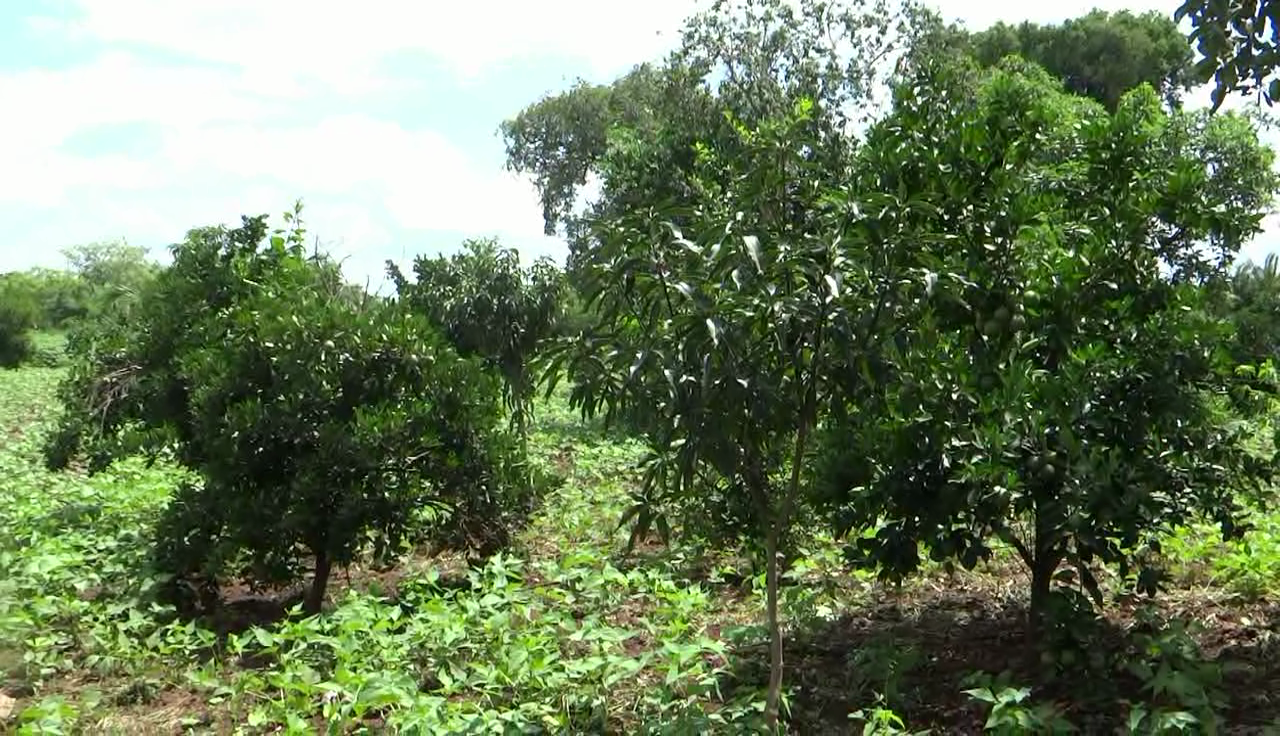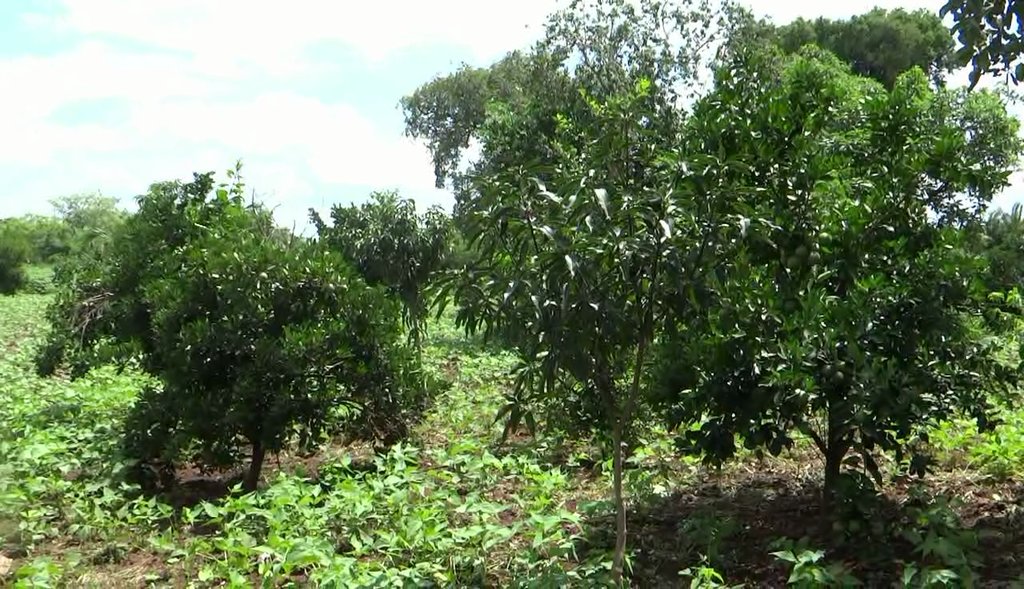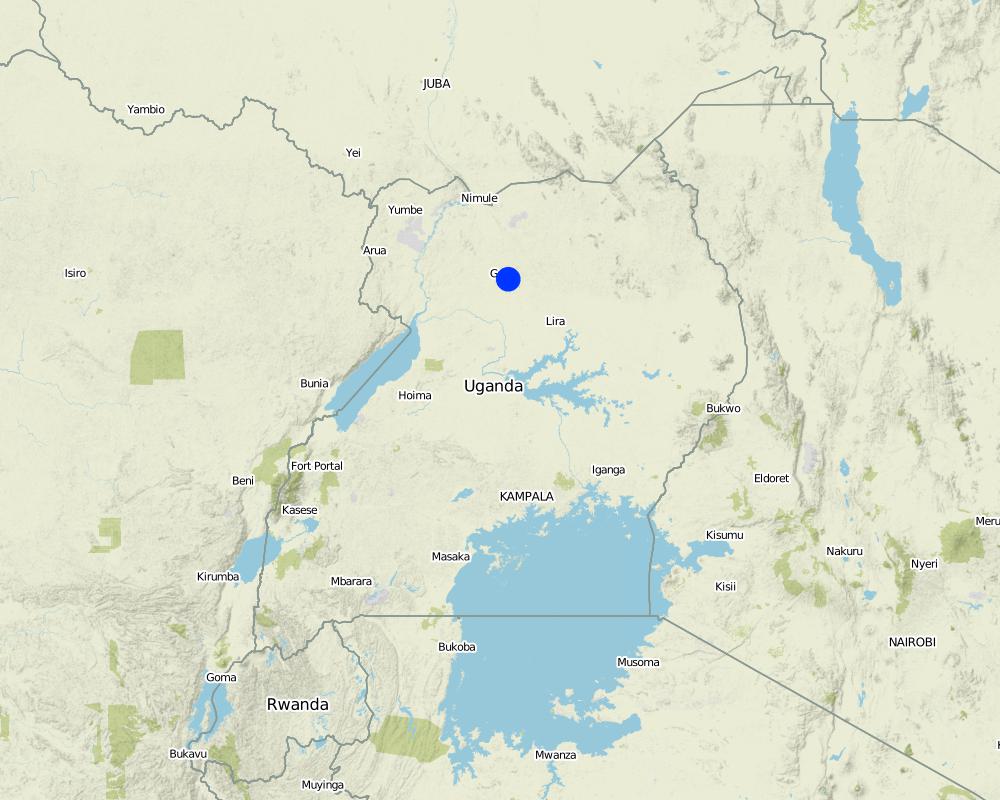Fruit Tree Orchard of Mangoes and Oranges Integrated with Beans [乌干达]
- 创建:
- 更新:
- 编制者: Kamugisha Rick Nelson
- 编辑者: JOY TUKAHIRWA, Richard Otto Kawawa, Sunday Balla Amale, Bernard Fungo
- 审查者: Donia Mühlematter, Drake Mubiru, Nicole Harari, Renate Fleiner
Mukungwa ki mayembe, muranga idyare
technologies_2787 - 乌干达
查看章节
全部展开 全部收起1. 一般信息
1.2 参与该技术评估和文件编制的资源人员和机构的联系方式
关键资源人
土地使用者:
Tusubira Peterson
Farmer
乌干达
有助于对技术进行记录/评估的项目名称(如相关)
Scaling-up SLM practices by smallholder farmers (IFAD)有助于对技术进行记录/评估的机构名称(如相关)
CDE Centre for Development and Environment (CDE Centre for Development and Environment) - 瑞士1.3 关于使用通过WOCAT记录的数据的条件
编制者和关键资源人员接受有关使用通过WOCAT记录数据的条件。:
是
1.4 所述技术的可持续性声明
这里所描述的技术在土地退化方面是否存在问题,导致无法被认为是一种可持续的土地管理技术?:
否
注释:
Sustainable - Good at controlling soil erosion and can be replicated else where.
2. SLM技术的说明
2.1 技术简介
技术定义:
Oranges (Citrus sinensis) and Mangoes (Mangifera indicate) integrated with beans are planted together in the same field to increase production and household income.
2.2 技术的详细说明
说明:
The technology is promoted by small scale farmers in Northern Uganda to address soil degradation including soil erosion, low crop productivity and low-income challenges both on farm and at household level. The farmer identified land with average size of 0.6 acres situated on a gentle sloping area (3-5%), measuring 45m wide x 95 m long planted with mangoes spaced 10m × 10m and oranges spaced 4m x 5m integrated with beans, NABE 14 and K20. The beans were planted using a line spacing of 10cm within a line and 30cm between lines with 2-3 seeds per hole. The selected bean varieties are high yielding and marketable. The following are the labour and input requirements for establishing this technology: a hoe, a tape measure, seedlings, 4 people and a panga.
Integration of beans into an already grown mango and orange field is a good and profitable practice because decomposition of the plant litter increases yields of the beans (nitrogen fixing) and the cost incurred, for example in weeding is less compared to the costs which would be incurred when the three enterprises (oranges, mangoes and beans) are planted separately on the same land.
Generally, benefits from implementing this technology are slightly positive ranging from improved soil fertility due to plant litter, reduced soil erosion with the fruit trees providing shade to the beans. After harvesting the beans, the farmer uses the bean waste/ residues as mulching material for the orchard which subsequently decomposes to provide manure. Also the beans cover reduces the moisture evaporation from the soil, thus keeping the soil moist
However, oranges, mangoes and beans are affected by pests and diseases and in case of this; the farmer is likely to suffer since they are planted in one field. The role of the extension worker is very critical at this stage in providing extension advisory services on how to spray the fruit trees when they get affected.
2.3 技术照片
2.4 技术视频
注释、简短说明:
Video on showing orchard of mangoes and oranges integrated with beans in Omolo District
日期:
15/12/2017
位置:
Aboli village, Abakri Parish, Kolo Sub-county, Omolo district
摄影师的名字:
Issa Aiga
2.5 已应用该技术的、本评估所涵盖的国家/地区/地点
国家:
乌干达
区域/州/省:
Northern Region,Uganda
有关地点的进一步说明:
Omolo district
具体说明该技术的分布:
- 均匀地分布在一个区域
如果不知道精确的区域,请注明大致覆盖的区域:
- < 0.1 平方千米(10 公顷)
注释:
Map showing technology site in Northern Uganda.
Map
×2.6 实施日期
注明实施年份:
2014
如果不知道确切的年份,请说明大概的日期:
- 不到10年前(最近)
2.7 技术介绍
详细说明该技术是如何引入的:
- 通过土地使用者的创新
- 通过项目/外部干预
注释(项目类型等):
Started on his own and later Operation Wealth Creation supported with training on how to space beans.
3. SLM技术的分类
3.1 该技术的主要目的
- 改良生产
- 减少、预防、恢复土地退化
- 创造有益的经济影响
3.4 供水
该技术所应用土地的供水:
- 雨养
3.5 该技术所属的SLM组
- 农业林学
- 农畜综合管理
- 改良的地面/植被覆盖
3.6 包含该技术的可持续土地管理措施

农艺措施
- A1:植被和土壤覆盖层
- A2:有机质/土壤肥力
- A5:种子管理,改良品种

植物措施
- V1:乔木和灌木覆盖层

结构措施
- S9:动植物庇护所
3.7 该技术强调的主要土地退化类型

土壤水蚀
- Wt:表土流失/地表侵蚀
- Wg:冲沟侵蚀/沟蚀
- Wo:场外劣化效应

土壤风蚀
- Et:表土流失

化学性土壤退化
- Cn:肥力下降和有机质含量下降(非侵蚀所致)

物理性土壤退化
- Pu:由于其他活动而导致生物生产功能的丧失

生物性退化
- Bc:植被覆盖的减少
- Bh:栖息地丧失
- Bl:土壤寿命损失
3.8 防止、减少或恢复土地退化
具体数量名该技术与土地退化有关的目标:
- 防止土地退化
- 减少土地退化
4. 技术规范、实施活动、投入和成本
4.1 该技术的技术图纸
4.2 有关投入和成本计算的一般信息
具体说明成本和投入是如何计算的:
- 每个技术区域
注明尺寸和面积单位:
0.6 acres of land
其它/国家货币(具体说明):
UGX
如相关,注明美元与当地货币的汇率(例如1美元=79.9巴西雷亚尔):1美元=:
3400.0
注明雇用劳工的每日平均工资成本:
5000
4.3 技术建立活动
| 活动 | 时间(季度) | |
|---|---|---|
| 1. | site selection planted with Oragnes and Mangoes | once before establishment |
| 2. | Look for labour and required tools | Before establishment |
| 3. | Look for bean seeds | Before establishment |
| 4. | Digging holes | During establishment |
| 5. | Planting seeds | During establishment |
4.4 技术建立所需要的费用和投入
| 对投入进行具体说明 | 单位 | 数量 | 单位成本 | 每项投入的总成本 | 土地使用者承担的成本% | |
|---|---|---|---|---|---|---|
| 劳动力 | persons days paid on monthly basis | persons | 4.0 | 150000.0 | 600000.0 | 100.0 |
| 设备 | Hoe | pieces | 4.0 | 10000.0 | 40000.0 | 100.0 |
| 设备 | Tape measure | pieces | 1.0 | 7000.0 | 7000.0 | 100.0 |
| 设备 | Panga | pieces | 2.0 | 7000.0 | 14000.0 | 100.0 |
| 植物材料 | Bean seeds | kgs | 100.0 | 2000.0 | 200000.0 | 100.0 |
| 肥料和杀菌剂 | Pestcide | litres | 2.0 | 25000.0 | 50000.0 | 100.0 |
| 其它 | Training | 1 | 1.0 | 50000.0 | 50000.0 | 40.0 |
| 技术建立所需总成本 | 961000.0 | |||||
注释:
Equipment are bought at the time of establishment. Work load reduces during maintenance. 60% of training (seeds, facilitation, extension agent) covered by Operation Wealth Creation.
4.5 维护/经常性活动
| 活动 | 时间/频率 | |
|---|---|---|
| 1. | Weeding | Once in a season |
| 2. | Spraying | Once in a season |
| 3. | Harvesting | Once in a season |
4.6 维护/经常性活动所需要的费用和投入(每年)
| 对投入进行具体说明 | 单位 | 数量 | 单位成本 | 每项投入的总成本 | 土地使用者承担的成本% | |
|---|---|---|---|---|---|---|
| 劳动力 | persons days on monthly basis | Persons | 3.0 | 150000.0 | 450000.0 | 100.0 |
| 设备 | Spraying pump | Pieces | 1.0 | 75000.0 | 75000.0 | 100.0 |
| 技术维护所需总成本 | 525000.0 | |||||
注释:
Labour costs are for weeding, spraying and harvesting.
4.7 影响成本的最重要因素
描述影响成本的最决定性因素:
Labour takes most of the cost during establishing. The farmer only buys a spraying pump for maintenance.
5. 自然和人文环境
5.1 气候
年降雨量
- < 250毫米
- 251-500毫米
- 501-750毫米
- 751-1,000毫米
- 1,001-1,500毫米
- 1,501-2,000毫米
- 2,001-3,000毫米
- 3,001-4,000毫米
- > 4,000毫米
指定年平均降雨量(若已知),单位为mm:
1500.00
有关降雨的规范/注释:
Nov- Dec and March -April.
农业气候带
- 潮湿的
- 半湿润
5.2 地形
平均坡度:
- 水平(0-2%)
- 缓降(3-5%)
- 平缓(6-10%)
- 滚坡(11-15%)
- 崎岖(16-30%)
- 陡峭(31-60%)
- 非常陡峭(>60%)
地形:
- 高原/平原
- 山脊
- 山坡
- 山地斜坡
- 麓坡
- 谷底
垂直分布带:
- 0-100 m a.s.l.
- 101-500 m a.s.l.
- 501-1,000 m a.s.l.
- 1,001-1,500 m a.s.l.
- 1,501-2,000 m a.s.l.
- 2,001-2,500 m a.s.l.
- 2,501-3,000 m a.s.l.
- 3,001-4,000 m a.s.l.
- > 4,000 m a.s.l.
说明该技术是否专门应用于:
- 凹陷情况
5.3 土壤
平均土层深度:
- 非常浅(0-20厘米)
- 浅(21-50厘米)
- 中等深度(51-80厘米)
- 深(81-120厘米)
- 非常深(> 120厘米)
土壤质地(表土):
- 中粒(壤土、粉土)
土壤质地(地表以下> 20厘米):
- 中粒(壤土、粉土)
表土有机质:
- 高(>3%)
- 中(1-3%)
5.4 水资源可用性和质量
地下水位表:
5-50米
地表水的可用性:
中等
水质(未处理):
良好饮用水
水的盐度有问题吗?:
否
该区域正在发生洪水吗?:
否
关于水质和水量的注释和进一步规范:
Soils are dry during Dec -March.
5.5 生物多样性
物种多样性:
- 低
栖息地多样性:
- 低
5.6 应用该技术的土地使用者的特征
定栖或游牧:
- 定栖的
生产系统的市场定位:
- 混合(生计/商业)
非农收入:
- 低于全部收入的10%
相对财富水平:
- 平均水平
个人或集体:
- 个人/家庭
机械化水平:
- 手工作业
性别:
- 女人
- 男人
土地使用者的年龄:
- 青年人
- 中年人
说明土地使用者的其他有关特征:
He is a business man dealing in a small merchandize items (salt, soap, beans).
5.7 应用该技术的土地使用者使用的平均土地面积
- < 0.5 公顷
- 0.5-1 公顷
- 1-2 公顷
- 2-5公顷
- 5-15公顷
- 15-50公顷
- 50-100公顷
- 100-500公顷
- 500-1,000公顷
- 1,000-10,000公顷
- > 10,000公顷
这被认为是小规模、中规模还是大规模的(参照当地实际情况)?:
- 小规模的
5.8 土地所有权、土地使用权和水使用权
土地所有权:
- 个人,未命名
土地使用权:
- 个人
用水权:
- 社区(有组织)
5.9 进入服务和基础设施的通道
健康:
- 贫瘠
- 适度的
- 好
教育:
- 贫瘠
- 适度的
- 好
技术援助:
- 贫瘠
- 适度的
- 好
就业(例如非农):
- 贫瘠
- 适度的
- 好
市场:
- 贫瘠
- 适度的
- 好
能源:
- 贫瘠
- 适度的
- 好
道路和交通:
- 贫瘠
- 适度的
- 好
饮用水和卫生设施:
- 贫瘠
- 适度的
- 好
金融服务:
- 贫瘠
- 适度的
- 好
6. 影响和结论性说明
6.1 该技术的现场影响
社会经济效应
生产
生产区域
注释/具体说明:
Increased due to use of the intercropping space.
土地管理
注释/具体说明:
Due to litter.
收入和成本
收入来源的多样性
注释/具体说明:
Fruits (oranges and mangoes) and beans.
工作量
注释/具体说明:
Weeding and harvesting.
社会文化影响
SLM/土地退化知识
注释/具体说明:
Spacing.
生态影响
土壤
土壤覆盖层
注释/具体说明:
Due to litter and mulching using bean residues.
土壤流失
土壤有机物/地下C
注释/具体说明:
Due to litter and mulching using bean residues.
生物多样性:植被、动物
植被覆盖
注释/具体说明:
Mulching using bean residues.
6.2 该技术的场外影响已经显现
水资源可用性
注释/具体说明:
Exposure to rainfall.
6.3 技术对渐变气候以及与气候相关的极端情况/灾害的暴露和敏感性(土地使用者认为的极端情况/灾害)
渐变气候
渐变气候
| 季节 | 增加或减少 | 该技术是如何应对的? | |
|---|---|---|---|
| 年降雨量 | 增加 | 好 | |
| 季雨量 | 湿季/雨季 | 增加 | 适度 |
气候有关的极端情况(灾害)
生物灾害
| 该技术是如何应对的? | |
|---|---|
| 流行病 | 适度 |
6.4 成本效益分析
技术收益与技术建立成本相比如何(从土地使用者的角度看)?
短期回报:
稍微积极
长期回报:
积极
技术收益与技术维护成本/经常性成本相比如何(从土地使用者的角度看)?
短期回报:
稍微积极
长期回报:
积极
注释:
High costs for paying for labour and buying seed during establishment.
6.5 技术采用
- 1-10%
如若可行,进行量化(住户数量和/或覆盖面积):
5
在所有采用这项技术的人当中,有多少人是自发的,即未获得任何物质奖励/付款?:
- 11-50%
注释:
Training offered by Operation Wealth Creation during integration of beans.
6.6 适应
最近是否对该技术进行了修改以适应不断变化的条件?:
是
若是,说明它适应了哪些变化的条件:
- 气候变化/极端气候
具体说明技术的适应性(设计、材料/品种等):
Put in place a tree nursery.
6.7 该技术的优点/长处/机会
| 土地使用者眼中的长处/优势/机会 |
|---|
| Oranges provide shade for beans during sunshine. |
| Oranges provide staking materials for beans. |
| Easy to manage and improves fertility of the soil. |
| High yield with integration/ one crop as an alternative in case of crop failure. |
| 编制者或其他关键资源人员认为的长处/优势/机会 |
|---|
| Bean residues act as mulching material and its decomposition increases fertility and moisture of the soil. |
| Can be replicated elsewhere with other farmers. |
6.8 技术的弱点/缺点/风险及其克服方法
| 土地使用者认为的弱点/缺点/风险 | 如何克服它们? |
|---|---|
| Labour intensive: planting, wedding, watering and harvesting. |
Work in groups. use family labour in addition to hired labour. |
| Easily affected by pests and diseases. |
Spray early enough before attack. Seek guidance from the extension services on how to manage pests and diseases. |
| 编制者或其他关键资源人员认为的弱点/缺点/风险 | 如何克服它们? |
|---|---|
| High costs for purchase of seeds and labours. |
Join small savings groups. Training on how farmers can have their own seeds and do it as a business. |
7. 参考和链接
7.1 信息的方法/来源
- 实地考察、实地调查
01
- 与土地使用者的访谈
01
- 与SLM专业人员/专家的访谈
01
(现场)数据是什么时候汇编的?:
25/05/2017
链接和模块
全部展开 全部收起链接
无链接
模块
无模块






